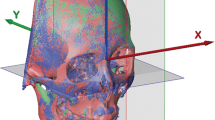Abstract
The treatment of mandibular deformities with an anterior open bite is challenging. In this study, skeletal stability after mandibular osteotomies was evaluated to determine the best treatment for mandibular prognathism with an anterior open bite in three procedures: intraoral vertical ramus osteotomy (IVRO), conventional sagittal split ramus osteotomy (conv-SSRO), and SSRO without bone fixation (nonfix-SSRO). Patients who underwent mandibular osteotomy to correct skeletal mandibular protrusion were included. Changes in skeletal and soft tissues were assessed using lateral cephalograms taken before (T1), 3 ± 2 days (T2), and 12 ± 3 months (T3) after surgery. Thirty-nine patients were included: nine in the IVRO group and 11 and 19 in the conv- and nonfix-SSRO groups, respectively. The mandibular plane angles (MPAs) of the T2–T1 were − 2.7 ± 2.0 (p = 0.0040), − 3.7 ± 1.7 (p < 0.0001), and − 2.3 ± 0.7 (p < 0.0001) in the IVRO, conv-SSRO, and nonfix-SSRO groups, respectively. The skeletal relapse of the MPAs was not related to the MPA at T2–T1, and it was approximately 1.3° in the conv-SSRO group. The skeletal relapse of the MAPs was significantly correlated with the MPA of T2–T1 in the IVRO (p = 0.0402) and non-fix-SSRO (p = 0.0173) groups. When the relapse of the MPAs was less than 1.3°, the MPA of T2–T1 was calculated as 2.5° in the nonfix-SSRO group. When the MPA of T2–T1 is less than 2.5°, non-fix SSRO may produce a reliable outcome, and when it is more than 2.5°, conv-SSRO may produce better outcomes.


Similar content being viewed by others
Data availability
All data generated or analyzed during this study are included in this published article.
References
Ohba S, Yoshida M, Kohara H, Kawasaki T, Minamizato T, Koga T, Natakani Y, Nakao N, Yoshida N, Asahina I. Short lingual osteotomy without fixation: A new strategy for mandibular osteotomy known as “Physiological Positioning.” Br J Oral Maxillofac Surg. 2014;52:e9–13.
Ohba S, Kohara H, Koga T, Kawasaki T, Miura K, Yoshida N, Asahina I. Soft tissue changes after a mandibular osteotomy for symmetric class III malocclusion. Odontology. 2017;105:375–81.
Ohba S, Nakao N, Nakatani Y, Kawasaki T, Minamizato T, Koga T, Kohara H, Yoshida N, Asahina I. The skeletal stability after maxillo-mandibular osteotomy with a “physiological positioning strategy.” Br J Oral Maxillofac Surg. 2014;52:965–9.
Marçan G, Öztaç E, Kuvat SV, Cura N, Emrkli U. Changes in soft tissue profile after mandibular setback surgery in Class III subjects. Int J Oral Maxillofac Surge. 2009;38:236–40.
Neeraj, Reddy SG, Dixit A, Agarwal P, Chowdhry R, Chung A. Relapse and temporomandibular joint dysfunction (TMD) as postoperative complication in skeletal class III patients undergoing bimaxillary orthognathic surgery: a systematic review. J Oral Biol Craniofac Res. 2021;11:467–75.
Reichert L, Figel P, Winchester L. Orthognathic treatment of anterior open bite: a review article—Is surgery always necessary? Oral Maxillifac Surg. 2014;18:271–7.
Milutinovic J, Zelic K, Nedeljkovic N. Evaluation of facial beauty using anthropometric proportions. Sci World J. 2014. https://doi.org/10.1155/2014/428250.
Chen CM, Lai SST, Wang CH, Wu JH, Lee KT, Lee HF. The stability of intraoral vertical ramus osteotomy and factors related to skeletal relapse. Aesth Plast Surg. 2011;35:192–7.
Möhlhenrich SC, Kniha K, Peters F, Ayoub N, Goloborodko E, Hölzle F, Modabber A. Fracture patterns after bilateral sagittal split osteotomy of the mandibular ramus according to the Obwegeser/Dal Pont ad Hunsuck/Epker modifications. J Craniomaxillofac Surg. 2017;45:762–7.
Ohba S, Tominaga J, Shido R, Koga T, Yamamoto H, Zaima H, Yoshida N, Asahina I. Influence of different treatment procedures on the temporomandibular joint after mandibular setback in skeletal class III—a retrospective study. J Craniomaxillofac Surg. 2022;50:712–8.
Kor HS, Yang HJ, Hwang SJ. Relapse of skeletal class III with anterior open bite after bimaxillary orthognathic surgery depending on maxillary posterior impaction and mandibular counterclockwise rotation. J Craniomaxillofac Surg. 2014;42:e230–8.
Moldez MA, Sugawara J, Umemori M, Mitani H, Kawamura H. Long-term dentofacial stability after bimaxillary surgery in skeletal class III open bite patients. Int J Adult Orthodon Orthogath Surg. 2000;15:309–19.
Kim SG, Park SS. Incidence of complications and problems related to orthognathic surgery. J Oral Maxillofac Surg. 2007;65:2482–2444.
Jędrzejewski M, Smektała T, Sporniak-Tutak K, Olszewski R. Preoperative, intraoperative, and postoperative complications in orthognathic surgery: a systematic review. Clin Oral Invest. 2015;19:969–77.
Choi SH, Cha JY, Park HS, Hwang CJ. Intraoral vertical ramus osteotomy results in good long-term mandibular stability in patients with mandibular prognathism and anterior open bite. J Oral Maxillofac Surg. 2016;74:804–10.
Mucedero M, Coviello A, Baccetti T, Franchi L, Cozza P. Stability factors after double-jaw surgery in class III malocclusion. A systematic review. Angle Orthod. 2008;78:1141–52.
Stansbury CD, Evans CA, Miloro M, BeGole EA, Morris DE. Stability of open bite correction with sagittal split osteotomy and closing rotation if the mandible. J Oral Maxillofac Surg. 2000;68:149–59.
Reyneke JO, Bryant RS, Suuronen R, Becker PJ. Postoperative skeletal stability following clockwise and counter-clockwise rotation of the maxillomandibular complex compared to conventional orthognathic treatment. Br J Oral Maxillofac Surg. 2007;45:56–64.
Acknowledgements
We thank Drs. Masahito Hara and Sousuke Ichinose for collecting the patient data in this study.
Author information
Authors and Affiliations
Corresponding author
Ethics declarations
Conflict of interest
The authors declare that they have no conflict of interest.
Additional information
Publisher's Note
Springer Nature remains neutral with regard to jurisdictional claims in published maps and institutional affiliations.
Rights and permissions
Springer Nature or its licensor (e.g. a society or other partner) holds exclusive rights to this article under a publishing agreement with the author(s) or other rightsholder(s); author self-archiving of the accepted manuscript version of this article is solely governed by the terms of such publishing agreement and applicable law.
About this article
Cite this article
Narahara, S., Morita, Y., Shido, R. et al. Comparison of the skeletal stability after mandibular counter-clockwise rotation in three surgical procedures. Odontology 112, 640–646 (2024). https://doi.org/10.1007/s10266-023-00860-7
Received:
Accepted:
Published:
Issue Date:
DOI: https://doi.org/10.1007/s10266-023-00860-7




